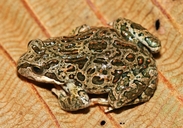|
Pleurodema marmoratum (Duméril & Bibron, 1840)
Marbled Four-eyed Frog | family: Leptodactylidae subfamily: Leiuperinae genus: Pleurodema |
 © 2011 Tiffany Kosch (1 of 4) |
|
|
|
Description The head of P. marmoratum is narrower than the body but is slightly wider than long. The snout is acutely rounded in dorsal view while sloping anteroventrally from lateral view. Supratympanic fold moderately heavy,obscuring upper and posterodorsal edges of tympanum. The length of the tympanum is 50-59.3% length of the eye. Vocal slits extend from midlateral base of the tongue toward angle of jaws. Vocal sac is single, median, and subgular. Toes moderately short, unwebbed, bearing narrow lateral fringes; toes III and IV are equal in length. In life the species is a dull green above and bright yellow below. Distribution and Habitat Country distribution from AmphibiaWeb's database: Bolivia, Chile, Peru
High elevation tropical environments are experiencing rapid change as a consequence of climate warming, and their glaciers are melting quickly. The ongoing deglaciation is opening up new aquatic habitats for pond-breeding amphibians. Seimon et al. (2017) describe the vertical migration of Pleurodema marmoratum, Rhinella spinulosa and Telmatobius marmoratum to newly deglaciated ponds up to elevations of 5400 m in the Andean Cordillera de Vilcanota of Peru. Life History, Abundance, Activity, and Special Behaviors Trends and Threats Comments
References
Duellman, W. E. (2000). ''Leptodactylid frogs of the genus Phrynopus in northern Peru with descriptions of three new species.'' Herpetologica, 56(3), 273-285. Seimon TA, Seimon A, Yager K, Reider K, Delgado A, Sowell P, Tupayachi A, Konecky B, McAloose D, Halloy S (2017). ''Long-term monitoring of tropical alpine habitat change, Andean anurans, and chytrid fungus in the Cordillera Vilcanota, Peru: Results from a decade of study.'' Ecology and Evolution, 7(5), 1527–1540. Originally submitted by: Raul E. Diaz (first posted 2004-08-27) Edited by: Kellie Whittaker, Alessandro Catenazzi and Sierra Raby (2017-04-25) Species Account Citation: AmphibiaWeb 2017 Pleurodema marmoratum: Marbled Four-eyed Frog <https://amphibiaweb.org/species/3430> University of California, Berkeley, CA, USA. Accessed Apr 1, 2025.
Feedback or comments about this page.
Citation: AmphibiaWeb. 2025. <https://amphibiaweb.org> University of California, Berkeley, CA, USA. Accessed 1 Apr 2025. AmphibiaWeb's policy on data use. |




 Map of Life
Map of Life